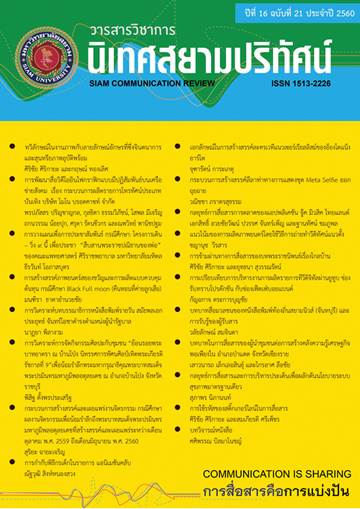ทวิลักษณ์ในงานภาพกับลายลักษณ์อักษร ที่ซึ่งจินตนาการและสุนทรียภาพอุบัติพร้อม
Main Article Content
บทคัดย่อ
ลักษณะทวิลักษณ์ (Duality) ของงานภาพกับลายลักษณ์อักษร เป็นคุณลักษณะของรูปสัญญะที่แสดงคุณสมบัติได้ทั้งสัญลักษณ์ภาพ (Figurative symbol) และสัญลักษณ์ทางภาษา (Discursive symbol) ในเวลาเดียวกัน ในทางตรงข้ามเมื่อการตีความข้ามพ้นไปจากจิตที่แบ่งแยกระหว่างระบบภาพและภาษา การรับรู้ความเป็นทวิลักษณ์จะเลือนหายไปก่อเกิดเป็นมิติใหม่ที่ข้ามก้าวสถานการณ์ (Situation shift) ของการสื่อความหมาย สู่โลกของคุณค่าและสุนทรียภาพอันเป็นอุบัติการณ์ใหม่ กลายเป็นรูปลักษณ์ของงานการสื่อสารที่ “พ้นภาษา” ด้วยคุณลักษณะดังกล่าวจึงทำให้วิธีการตีความหมายแตกต่างไปจากจารีตทางการสื่อสารแบบเดิม
บทความนี้มุ่งเน้นการอธิบายลักษณะการประกอบสร้างและการตีความสารที่มองแบบระดับพื้นผิว จะเห็นว่ามีลักษณะทวิลักษณ์ โดยตั้งอยู่บนขอบเขตที่ไม่ชัดเจนระหว่างการสื่อความหมายผ่านไวยากรณ์ด้านภาพและภาษา ทั้งยังเป็นงานที่สื่อสารสนเทศร่วมกับจังหวะอารมณ์และความงามอย่างน่าสนใจ มีศักยภาพในการยั่วยวนให้คนดูเข้ามามีส่วนร่วมและแบ่งปันประสบการณ์เพื่อรังสรรค์คุณค่าและสุนทรียภาพที่มีพลังในการกระตุ้นปฏิสัมพันธ์ทางการสื่อสารได้ตรงใจคนแต่ละคน
Article Details
เอกสารอ้างอิง
โรเวลลี คาร์โล (2560). ความงามแห่งฟิสิกส์. แปลโดย สุนันทา วรรณสิทธิ์ เบล. กรุงเทพฯ สำนักพิมพ์โอเพ่นเวิลด์ส.
ศิริชัย ศิริกายะ. (2559). ทฤษฎีควอนตัมฟิสิกส์กับการควบรวมและการแปลงรูปองค์ประกอบการสื่อสารในยุคดิจิทัล. นิเทศสยามปริทัศน์. 15 (19): 7-9.
James C. McCroskey and Lawrence R. Wheeless .(1976). Introduction to Human communication. Boston: Allyn and Bacon,. Inc.
Leonard Shain. (1999). Art&Physics: Parallel visions in space, time, and light. New York: William Morrow and Company, Inc.
Marshall. McLuhan. Understanding Media. The Extensions of Man. New York : McGraw-Hill Book Company
Rudolf Arnheim. (1969). Visual thinking. L.A.: University of California Press.
Smeg. (2017). Smeg technology with style. Retrieved from http://www.smeg.com/product/small-domestic-appliances/


